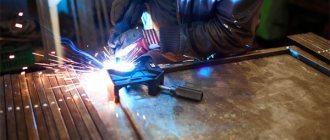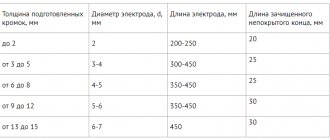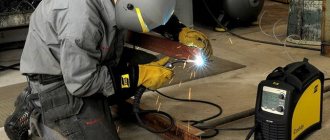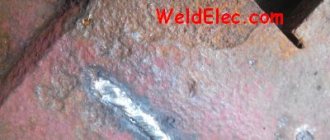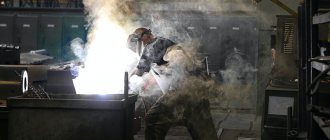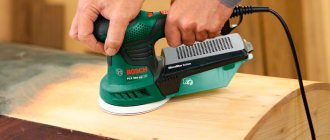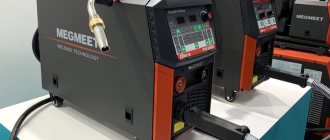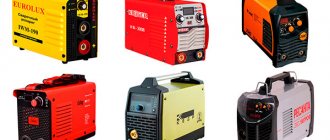The use of electrodes in the welding process is widespread today. It is almost impossible to give an unambiguous answer regarding the choice of brand of electrode products, because the subjective opinion of the welder is integrally involved in the selection process.
In today’s article I will try to analyze as objectively as possible which electrodes to choose for welding with an inverter for a beginner + what according to TM in 2021-2022 is considered the most relevant for use by welders.
Electrodes for inverter welding - choosing the best
| Photo | Name | Rating | Price | |||
| The best welding electrodes with basic coating | ||||||
| #1 | Kobelco LB-52U | ⭐ 4.95 / 5 56 — votes | Find out the price | |||
| #2 | ESAB SSSI 13/55 | ⭐ 4.9 / 5 45 — votes | Find out the price | |||
| #3 | Cedar OZL-8 | ⭐ 4.85 / 5 12 — votes | Find out the price | |||
| #4 | Lincoln Electric SSSI 13/55 | ⭐ 4.8 / 5 35 — votes | Find out the price | |||
| #5 | Wester UONII-13/55 | ⭐ 4.75 / 5 10 — votes | Find out the price | |||
| The best rutile coated welding electrodes | ||||||
| #1 | ESAB-SVEL OK 46.00 | ⭐ 4.95 / 5 173 - votes | Find out the price | |||
| #2 | Resanta MP-3 | ⭐ 4.9 / 5 115 — votes | Find out the price | |||
| #3 | Fubag FB3 | ⭐ 4.85 / 5 44 - votes | Find out the price | |||
| #4 | Sibrtech MP-3C | ⭐ 4.8 / 5 17 — votes | Find out the price | |||
| #5 | Quattro Elementi 770-421 | ⭐ 4.75 / 5 24 - votes | Find out the price | |||
Which welding electrodes would you choose or recommend?
Take the survey
Our small rating of welding electrodes will help you make the right choice. Let us remind you that the opinion of the site’s editors does not necessarily coincide with the opinion of readers. You can buy completely different electrodes without being guided by our choice.
For ease of reading the material, we have divided the list of electrode models into two parts. One presents options with a basic coating, and the other with rutile. These are the most common coating options and are in greatest demand. We'll talk more about the types of coating below, and now for you - the TOP 10 electrodes used for welding with an inverter.
Ratings
The best (popular) brands of electrodes
Materials for cast iron and stainless steel are not included due to their specificity.
The best (popular) electrode manufacturers
If you see that the ratings are missing a well-deserved brand or manufacturer, write in the comments, they will be added to the survey.
We also recommend that you read the material “How to choose electrodes for welding”, it gives advice based on what exactly you are going to weld.
The best welding electrodes with basic coating
No. 5 - Wester UONII-13/55
Wester UONII-13/55
This option is recommended for welding work carried out with products made of low-alloy or carbon steel, and requiring the creation of a very strong and high-quality seam.
This is a universal type electrode, designed for manual arc welding. You can work with it in all spatial directions, with the exception of the vertical position when moving from top to bottom. Approximate consumption - 1.6 kg per 1 kg of metal.
Users note that these electrodes are very cheap, and this is their main advantage. But, unfortunately, not in all conditions they allow you to get an excellent, durable seam. Yes, and they need to be heated very well before work. In general, they are well suited for domestic use - in the garage, at the dacha.
pros
- low price
- relatively low consumption
- optimal for home use
- allows you to get a strong seam
- convenient packaging
Minuses
- do not always allow you to create a good seam
- You should always bake it well before work.
Prices for Wester UONII-13/55 electrodes
Wester UONII-13/55
No. 4 - Lincoln Electric SSSI 13/55
Lincoln Electric UONI 13/55
Such electrodes are used mainly for welding low-alloy and carbon steel. Previously they were called Oryol. Now they are produced at the Mezhgosmetiz-Mtsensk enterprise, but the technologies of the Lincoln Electric company are taken as the basis. Thus, it was possible to improve the quality of these elements, but did not increase their cost.
This universal electrode is used for manual arc welding. It is designed specifically for welding using direct current. The model has the main type of coating, gray color. The electrodes are not afraid of environmental factors, are suitable for working with thick metal (the main thing is to choose the correct thickness of the electrode), and allow you to achieve a durable and at the same time sufficiently plastic seam. Consumption - 1.7 kg per 1 kg of metal. It is noted that the electrodes can be used for welding work on objects located in low temperature conditions.
pros
- inexpensive
- Russian production
- immune to environmental factors
- Allows you to work with thick metal
- provide a plastic seam
- can be used at low temperatures
Minuses
- not detected
Prices for Lincoln Electric electrodes UONI 13/55
Lincoln Electric SSSI 13/55
No. 3 – Kedr OZL-8
Cedar OZL-8
This option is designed specifically for welding stainless steel. It has a basic coating type and requires pre-calcination for 60 minutes. Suitable for working in all directions of space, except vertically from top to bottom.
Easy ignition, both primary and secondary, good uniform combustion are the main advantages of this Russian-made electrode. But during the work, quite a lot of slag is formed, which often shoots off, especially when working with thin metal. The electrodes are very carefully packaged and, taken straight from the package, allow you to start working even without calcination.
pros
- low cost
- Russian production
- excellent ignition
- uniform combustion
- form a stable arc
Minuses
- form a lot of slag
Prices for electrodes Kedr OZL-8
Cedar OZL-8
No. 2 - ESAB UONI 13/55
ESAB UONI 13/55
Inexpensive, but one of the most popular electrodes that have a basic coating and are designed to work with direct current. They are recommended for work where great responsibility is required, and the final seam should be strong and neat. Consumption is low - 1.7 kg. Before starting work, preliminary calcination lasting about 60 minutes is required. But you can cook with such an electrode in absolutely any spatial position.
The main disadvantage is the difficult ignition. And therefore, this option of electrodes is not the best for a novice welder. Re-igniting is also not an easy task. But, we repeat, it is with such electrodes that it is possible to obtain a beautiful and durable seam. And slag ulcers practically do not form. The electrode is optimal for working with carbon steel.
pros
- Can be cooked in any position
- It turns out a beautiful and very durable seam
- no slag ulcers are formed
- inexpensive
- very popular
Minuses
- complex arson
- not suitable for a beginner
Prices for ESAB UONI 13/55 electrodes
ESAB SSSI 13/55
No. 1 - Kobelco LB-52U
Kobelco LB-52U
Electrode designed to work with carbon steel, having a basic coating type. This option does not require long-term calcination before starting work - it only takes 30 minutes.
A rather expensive option for the Russian consumer, since it is produced in Japan, which means that transport costs for delivery to the Russian Federation are high. But this is a really worthwhile product: the electrode is ideal for working with low-carbon steel and does an excellent job of welding all kinds of pipes. The seam is as strong and reliable as possible, which is why such electrodes are valued by experienced welders.
pros
- Japanese quality
- give the strongest seam
- short annealing time
- neatness of work
- suitable for pipe welding
- you can work in any direction
Minuses
- high price
Prices for Kobelco LB-52U electrodes
Kobelco LB-52U
Reviews of Kobelco LB-52U electrodes
Selection of products according to other parameters
The type of current, as well as the polarity of its connection, are the most important parameters of welding operations. Welding inverters primarily produce direct current, which can be connected to the workpiece and the electrode in two circuits.
- Straight polarity. With this scheme, the plus is connected to ground, and the minus to the welding electrode.
- Reverse polarity. This scheme involves connecting the minus to ground, and the plus, respectively, to the holder with the electrode.
If you cook with an inverter using straight polarity, the surfaces being connected are subject to significant heating, which does not happen when connecting the polarity in the opposite way. This is why choosing reverse polarity is advisable in the following situations.
- When welding parts of small thickness with an inverter. Reverse polarity in such cases will help protect the material from burn-through.
- Reverse polarity is used to weld parts made of high-alloy steels, which are very sensitive to overheating.
Working with inverter welding
Direct polarity, during which the workpiece is subjected to significant heating, is optimally used for joining materials that are very thick and massive.
When performing any welding work using an inverter, the most significant are three parameters that are interconnected:
- welding current strength;
- electrode diameter;
- thickness of the parts to be connected.
The thickness of the parts being connected has a direct influence on the choice of electrodes. If it is necessary to connect thin parts (up to 1.5 mm), manual welding is not used; semi-automatic machines or devices that allow welding in a protective argon environment are better suited for this purpose.
Options for electrode position when welding
When deciding which electrodes to choose for welding structures of a certain thickness, you can be guided by the following criteria:
- for parts whose thickness is 2 mm, electrodes Ø 2.5 mm are best suited;
- when connecting parts with a thickness of 3 mm, you should choose electrodes Ø 2.5–3 mm;
- if the thickness of the parts to be welded is 4–5 mm, then electrodes Ø 3.2–4 mm are suitable;
- parts with a thickness of 6–12 mm are best welded with electrodes Ø 4–5 mm;
- when the thickness exceeds 13 mm, then the optimal choice is electrodes Ø 5 mm.
It is very important to choose the correct diameter of the electrodes, since if this parameter is exceeded, the welding current density decreases. This will lead to the welding arc becoming unstable, the penetration of parts will deteriorate, and the width of the weld will increase. Many manufacturers indicate on the packaging information about the best current values to use.
Welding electrodes
If such information is not contained on the packaging, then you can follow the following recommendations:
- for welding with electrodes Ø 2 mm, the welding current should be set to 55–65A;
- for products Ø 2.5 mm, a current of 65–80A is used;
- electrodes Ø 3 mm - current 70–130A;
- for electrodes Ø 4 mm, choose a welding current of 130–160 A;
- products Ø 5 mm - current 180–210 A;
- It is better to cook with 6 mm electrodes at a current of 210–240 A.
As it becomes clear from all of the above, for high-quality welding with an inverter, the correct choice of electrodes according to their diameter is important. You should also set the optimal welding current. If, for example, you plan to weld thin metal with an inverter, using large-diameter electrodes, or the welding current exceeds the permissible values, then pores may form in the finished weld, which will significantly reduce its quality characteristics.
» data-lazy-type=»iframe» src=»data:image/gif;base64,R0lGODlhAQABAIAAAAAAAP///yH5BAEAAAAALAAAAAABAAEAAAIBRAA7″>
The best rutile coated welding electrodes
No. 5 - Quattro Elementi 770-421
Quattro Elementi 770-421
A universal, very cheap electrode with rutile coating, packaged conscientiously by the manufacturer and therefore does not lose its properties when properly stored. Can be used in any direction except vertical from top to bottom. Consumption is 1.7 kg per 1 kg of metal.
The electrode is designed for welding low-carbon and low-alloy metals and is often used in mechanical engineering and construction. The arc during operation is powerful and stable. No pores are formed in the seams during welding. Cons: There are very few pieces in the package.
pros
- hold the arc perfectly
- low price
- easy ignition
- make a beautiful seam
- good packing
Minuses
- small number of electrodes per package
Prices for electrodes Quattro Elementi 770-421
Quattro Elementi 770-421
No. 4 - Sibrtech MP-3C
Sibrtech MP-3C
Rutile electrode for manual welding, which is suitable for various operating modes. It can be used for products that have completely different orientations in space - there are no restrictions.
Many users consider these electrodes to be one of the best, with virtually no drawbacks. They are inexpensive, allow you to obtain high-quality welding results, and are suitable for working with critical structures. They burn softly, but it’s not easy to light them - and this is the main disadvantage.
pros
- inexpensive
- hold the arc perfectly
- you can work in all directions
- Excellent value for money and quality
- allows you to get a beautiful seam
Minuses
- difficult to light
Prices for Sibrtech MP-3C electrodes
Sibrtech MP-3C
No. 3 - Fubag FB3
Fubag FB3
An inexpensive rutile-coated electrode used for manual arc welding, which many consider to be quite good for its price. Well packaged, which is why it is virtually unaffected by the environment during long-term storage. Suitable for welding in various spatial positions.
The electrode ensures ease of welding and can be ignited both initially and re-ignited without much difficulty. The arc burns steadily throughout the entire working process. Overall, the electrode produces little slag.
pros
- low price
- can be used in various spatial positions
- form little slag
- easy to light
- good packing
Minuses
- not detected
Prices for Fubag FB3 electrodes
Fubag FB3
No. 2 - Resanta MR-3
Resanta MP-3
These are one of the most common rutile-coated electrodes in Russia, receiving virtually no complaints from welders. They are sold at a reasonable price, practically do not become damp during storage, and allow you to obtain a strong and reliable seam.
The electrode requires calcination before starting work; the duration of calcination is about 60 minutes, but at a relatively low temperature of up to 170 degrees. The product is very easy to ignite and allows you to conduct an arc in any direction. It behaves equally well when working with a wide variety of steel types.
pros
- reasonable price
- easy to light
- Can work with different types of steel
- provide a strong seam
- very popular option
- slag is easily separated
Minuses
- require long-term calcination
Prices for Resanta MP-3 electrodes
Resanta MP-3
No. 1 - ESAB-SVEL OK 46.00
ESAB-SVEL OK 46.00
Electrodes that are produced in Russia, but under the control of a company from Sweden. Moderate cost and high quality results make these products one of the most popular and among the best on the market according to many.
These electrodes provide a good stable arc, burn well even with slight dampness, and ignite excellently. They can be used for different types of welding, in any spatial direction. The seam resulting from working with such electrodes turns out beautiful. Calcination occurs at very low temperatures - around 90 degrees.
pros
- nice price
- produced under Swedish control
- Can work with dirty or rusty metal
- easy to light
- provide excellent arc
Minuses
- not suitable for pipe welding
Prices for electrodes ESAB-SVEL OK 46.00
ESAB-SVEL OK 46.00
Reviews of electrodes ESAB-SVEL OK 46.00
What is a welding inverter?
Welding is a difficult and responsible process. Anyone can master this craft if they wish, but if previously they had to use complex and bulky equipment for work, now it is enough to purchase a welding inverter, which greatly simplifies the task. This is a relatively small device that weighs much less than any other welding machine. This made it possible to simplify and facilitate the welding process. Nowadays, the welding inverter has practically replaced standard welding machines from the market.
How does a welding inverter work? The voltage coming from the mains is supplied to the so-called rectifier, then the direct current is converted into alternating current due to a special power module. But alternating current has a higher frequency. This, in turn, is fed to a welding transformer, and the voltage from it, after rectification, is supplied to a very stable welding arc.
Welding inverter CALIBR SVI-250 4600 W
The main advantages of a welding inverter:
- relatively light weight of the device;
- improvement of arc characteristics;
- increased efficiency;
- the ability to reduce the amount of splashes during work;
- different electrodes can be used;
- wide current adjustment range;
- simplified electrode ignition;
- you can get a more durable and high-quality seam;
- it is easier to master the craft of a welder;
- the electrodes almost do not stick when in contact with the part.
Of course, there are also disadvantages. At a minimum, this is the high cost of the equipment (three times more than conventional transformers). It is also important to clean inverters regularly from dust - at least once a year. And you won’t be able to work with them in the cold - the devices don’t like the cold. Also, the network cable required to connect the device to the electrical network cannot exceed a length of 2.5 m.
Important! It is not always possible to use an inverter for welding at temperatures below -15 degrees. Here it is important to study the instructions for the selected device model and follow the manufacturer’s recommendations.
Selection criteria
Unfortunately, Russian electrodes are inferior to many foreign analogues in most parameters. However, “breakthroughs” in this area have already emerged. Russian electrode products, produced at the still few joint ventures, are no longer inferior to many venerable brands in terms of quality stability. Some factories of domestic subordination also began to “catch up” to them. However, in cases where it is necessary to confidently ensure high quality of the seam, professionals still prefer to use more expensive, but also higher quality, foreign-made electrodes. Electrodes of any type are suitable for welding inverters; not all types are suitable for AC welding machines.
When selecting the best electrodes for review, we were guided by the following criteria:
For a fair comparison of prices, we included in the review only the most commonly used electrodes with a diameter of 3 mm.
The main parameter of any welding electrode, which determines most of its properties - from ease of ignition to the quality of the seam - is the composition of its coating. The most common types of coatings today are:
Source
Electrode device
Design of a welding electrode
The electrode, which is necessarily used during welding, is a fairly thin metal product that resembles a knitting needle in appearance and has a special coating. During welding, the metal of the core begins to melt, and the coating applied to it protects the formed seam from exposure to oxygen. By the way, the coating of products can be very different.
Schematic illustration of the welding process
Table. Types of coating.
| Type | Description |
| Basic | Optimal products for working with so-called critical structures, pipes. During welding work, ductile and durable joints are obtained that are not prone to oxidation. Crystallization cracks rarely occur on the seam. Marking with the letter B. The coating contains carbon compounds of magnesium and calcium, there is practically no hydrogen, due to which a decrease in the characteristics of the metals being welded does not occur. Electrodes with such coating are used only on direct current. The main disadvantage is that a lot of slag is formed during operation. And one more thing - before working with such an electrode, the surface to be welded must be thoroughly cleaned of oils, rust, scale, etc., otherwise there is a risk of getting pores inside the weld, which reduce its strength. |
| Rutile | Such electrodes light up easily and practically do not splash metal around them. They are marked with the letter P. The coating is based on the substance rutile, there is also oxygen and silicon. This coating option is available on electrodes used in direct and alternating current conditions. It is important to work in conditions of moderate humidity, otherwise the quality of the seam will deteriorate greatly. |
| Cellulose | This coating contains a lot of organic matter (up to 50%). These are organic resins and cellulose itself. The marking of such electrodes is letter C. During work, they emit little slag, but form a lot of gases. It is easy for them to perform work in a vertical orientation. Options with such coating are used only on direct current. Disadvantages - a lot of splashes are generated, and the quality of the weld when working with steel may not be the best due to the high hydrogen content. |
| Sour | Such electrodes make it possible to obtain a welding seam with virtually no air channels; they can be used to weld elements with scale and rusty parts. It contains manganese, iron, silicon and a number of other elements. Such electrodes are marked with the letter A. This option is harmful to the health of the welder and requires work to be carried out exclusively in a well-ventilated area. There is also another disadvantage - the risk of hot cracks appearing in the seam. |
On a note! For novice welders, it is best to use rutile electrodes. For experienced people, it doesn’t matter what kind of coating is used.
Rutile electrodes
Also, all electrodes are divided into two main groups - melting and non-melting.
- Melting options may have a coated rod of different diameters. It is thanks to the latter that the arc during welding is optimal. Such electrodes are usually used for manual welding.
- Non-melting options are now quite rare, since they need to be worked in a special environment. They are difficult to select, so they are not recommended for beginners.
Why is coating needed?
Coating applied to the surface of the rod:
- prevents saturation of the melt with harmful impurities;
- protects the seam from cracking during cooling;
- neutralizes oxides and other contaminants found on parts being welded;
- improves the appearance of the seam regardless of spatial orientation.
Composition of the coating of welding electrodes
The coating is applied at the factory; the stability of the arc depends on the thickness of the layer. When heated, the coating melts and partially burns, forming a protective cloud of gases. After welding is completed, the seam is cleaned of the frozen coating using a hammer or an abrasive tool. All protective coating options actively absorb water, which negatively affects the performance.
Before welding, wet electrodes must be kept in an electric furnace (the duration and mode of heat treatment depend on the brand of product).
How to choose electrodes for inverter welding
When choosing these products, the most important thing is to decide what material you will have to work with. That is, it is important to know what the products being welded are made of, and the composition of the electrode core must match them in composition.
Thus, electrodes can be classified according to a number of characteristics:
- for low-carbon metals, carbon options are used;
- for cast iron;
- for strong heat-resistant steels;
- for high alloy metal;
- for working with aluminum or copper versions of products;
- for surfacing and repair work;
- universal options.
Electrodes for cast iron
Electrodes used for work must not be damaged. It is also important that they are dry. Special ovens are used to dry products.
Advice! To dry the electrodes at home, you can use a conventional oven. But it is best not to let the products get wet and store them in airtight containers in a dry and warm place. Otherwise, there is a high risk that the electrodes will begin to stick during operation.
Experienced specialists also take into account the conditions in which the work will be carried out. For example, humidity, ambient temperature, etc. It is also important to consider the diameter of the selected electrode, the thickness of the parts and the current strength. It is important to understand that if the product is selected incorrectly, the current density can be reduced. As a result, the quality of welding will leave much to be desired, the seam will be thick and wide. Typically, electrode manufacturers immediately indicate for what current strength the product is best suited. For complex and massive structures, it is better to take thick electrodes, while profile products are welded in versions up to only 2 mm thick. We suggest estimating the approximate ratio of metal thickness and diameter using the figure below.
Ratio of workpiece thickness and electrode diameter
And here are the recommended current values depending on the thickness of the product.
Relationship between electrode diameter and welding current
Foreign manufacturers
Answering the question “Which electrodes to choose for welding with an inverter?” It is worth mentioning foreign manufacturers. There are many brands on our market, but we will focus on European ones. In our opinion, Abicor Binzel, ESAB, Böhler Welding and ELGA are the best.
Whatever manufacturer you choose, their products can be used to carry out all types of welding work: welding carbon steel, pipe joints, performing particularly complex work with difficult-to-weld metal, welding cast iron, copper and aluminum. If you cook to order or perform work with an increased degree of responsibility, then choose foreign manufacturers. Their quality is many times higher than the products of Russian manufacturers, since there is strict control in production.
User voting
Which welding electrodes would you choose or recommend?
Kobelco LB-52U
10.55 % ( 56 )
ESAB SSSI 13/55
8.47 % ( 45 )
Cedar OZL-8
2.26 % ( 12 )
Lincoln Electric SSSI 13/55
6.59 % ( 35 )
Wester UONII-13/55
1.88 % ( 10 )
ESAB-SVEL OK 46.00
32.58 % ( 173 )
Resanta MP-3
21.66 % ( 115 )
Fubag FB3
8.29 % ( 44 )
Sibrtech MP-3C
3.20 % ( 17 )

